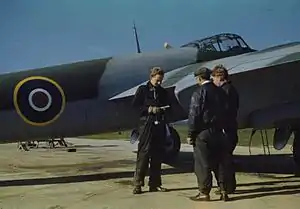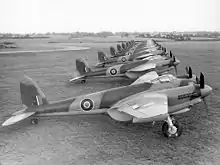John de Havilland | |
|---|---|
 John de Havilland (left) checking the flight log book with two fitters beside a Mosquito after a test flight, 1943 | |
| Born | 17 October 1918 |
| Died | 23 August 1943 (aged 24) Hatfield, Hertfordshire, England |
| Nationality | British |
| Occupation | Test pilot |
| Parent |
|
John de Havilland (17 October 1918 – 23 August 1943) was a British test pilot.[1]
John and his brothers, Geoffrey de Havilland Jr. and Peter, were sons of Geoffrey de Havilland, the famous designer and manufacturer.[2] All three brothers were pilots and flew as test pilots for the de Havilland company. John had been a sergeant in the Royal Air Force Volunteer Reserve (RAFVR) prior to the Second World War. Due to the demands for pilots in the de Havilland company, he was released from service and joined his father's firm.[3]

During a test flight of a de Havilland Mosquito Mark VI, flying with flight test observer John H. F. Scrope, he collided in the vicinity of St Albans with another Mosquito Mark VI flown by pilot George Gibbins.[4] Both aircraft disintegrated in the air, killing all four occupants aboard. Godfrey J. Carter was flying as an observer in Gibbins's aircraft.[5]
The John de Havilland Scholarship Fund was set up by Geoffrey de Havilland after his son's death. The award is associated with the aviation industry and its purpose is to develop the industry by recognising exceptional young people who will enter the profession.[6]
| de Havilland family tree | |||||||||||||||||||||||||||||||||||||||||||||||||||||||||||||||||||||||||||||||||||||||||||||||||||||||||||||||||||||||||||||||||||||||||||||||||||||||||||||||||||||||||||||||||||||||||||||||||||||||||||||||||||||||||||||||||||||||||||||||||||||||||||||||||||||||||||||||||||||||||||||||||||||||||||||||||||||||||||||||||||||||||||||||||||||||||||||||||||||||||||||||||||||||||||||||||||||||||||||||||||||||||||||||||||||||||||||||||||||||||||||||||||||||||||||||||||||||||||||||||||||||||||||||||||||||||||||||||||||
|---|---|---|---|---|---|---|---|---|---|---|---|---|---|---|---|---|---|---|---|---|---|---|---|---|---|---|---|---|---|---|---|---|---|---|---|---|---|---|---|---|---|---|---|---|---|---|---|---|---|---|---|---|---|---|---|---|---|---|---|---|---|---|---|---|---|---|---|---|---|---|---|---|---|---|---|---|---|---|---|---|---|---|---|---|---|---|---|---|---|---|---|---|---|---|---|---|---|---|---|---|---|---|---|---|---|---|---|---|---|---|---|---|---|---|---|---|---|---|---|---|---|---|---|---|---|---|---|---|---|---|---|---|---|---|---|---|---|---|---|---|---|---|---|---|---|---|---|---|---|---|---|---|---|---|---|---|---|---|---|---|---|---|---|---|---|---|---|---|---|---|---|---|---|---|---|---|---|---|---|---|---|---|---|---|---|---|---|---|---|---|---|---|---|---|---|---|---|---|---|---|---|---|---|---|---|---|---|---|---|---|---|---|---|---|---|---|---|---|---|---|---|---|---|---|---|---|---|---|---|---|---|---|---|---|---|---|---|---|---|---|---|---|---|---|---|---|---|---|---|---|---|---|---|---|---|---|---|---|---|---|---|---|---|---|---|---|---|---|---|---|---|---|---|---|---|---|---|---|---|---|---|---|---|---|---|---|---|---|---|---|---|---|---|---|---|---|---|---|---|---|---|---|---|---|---|---|---|---|---|---|---|---|---|---|---|---|---|---|---|---|---|---|---|---|---|---|---|---|---|---|---|---|---|---|---|---|---|---|---|---|---|---|---|---|---|---|---|---|---|---|---|---|---|---|---|---|---|---|---|---|---|---|---|---|---|---|---|---|---|---|---|---|---|---|---|---|---|---|---|---|---|---|---|---|---|---|---|---|---|---|---|---|---|---|---|---|---|---|---|---|---|---|---|---|---|---|---|---|---|---|---|---|---|---|---|---|---|---|---|---|---|---|---|---|---|---|---|---|---|---|---|---|---|---|---|---|---|---|---|---|---|---|---|---|---|---|---|---|---|---|---|---|---|---|---|---|---|---|---|---|---|---|---|---|---|---|---|---|---|---|---|---|---|---|---|---|---|---|---|---|---|---|---|---|---|---|---|---|---|---|---|---|---|---|---|---|---|---|---|---|---|---|---|---|---|---|---|---|---|---|---|---|---|---|---|---|---|
| |||||||||||||||||||||||||||||||||||||||||||||||||||||||||||||||||||||||||||||||||||||||||||||||||||||||||||||||||||||||||||||||||||||||||||||||||||||||||||||||||||||||||||||||||||||||||||||||||||||||||||||||||||||||||||||||||||||||||||||||||||||||||||||||||||||||||||||||||||||||||||||||||||||||||||||||||||||||||||||||||||||||||||||||||||||||||||||||||||||||||||||||||||||||||||||||||||||||||||||||||||||||||||||||||||||||||||||||||||||||||||||||||||||||||||||||||||||||||||||||||||||||||||||||||||||||||||||||||||||
References
- ↑ Burke, B. (1965). Genealogical and Heraldic History of the Landed Gentry: Founded 1836 by John Burke and Sir Bernard Burke. Burke's Peerage. p. 196. ISBN 9780850110067. Retrieved 13 February 2018.
- ↑ Society, H.L.H. (2016). Taking Off: Memories of de Havilland at Hatfield. Hatfield Local History Society. p. 52. ISBN 978-0-9928416-5-2. Retrieved 13 February 2018.
- ↑ Aeronautics. 1943. p. 16. Retrieved 13 February 2018.
John de Havilland was 25, single, and lived at Bushey Heath. As soon as he was old enough to do so he followed the examples of his father and two brothers, Geoffrey and Peter, and qualified as a pilot. He entered the Royal Air Force Volunteer Reserve some time before the outbreak of war, and was a sergeant-pilot. He was mobilised immediately hostilities opened, and joined his unit. Subsequently, when the de Havilland Company was in urgent need of test pilots, he was released ...
- ↑ Kingdom, Royal Aero Club of the United; Club, United Service and Royal Aero (1943). Flight International. IPC Transport Press Limited. p. 249. Retrieved 13 February 2018.
- ↑ Lawrence, B.G. (2016). Hatfield at War: The story of life in a small town in 1939–45. Hatfield Local History Society. p. 62. ISBN 978-0-9928416-6-9. Retrieved 13 February 2018.
- ↑ Kingdom, Royal Aero Club of the United (1960). Flight International. IPC Transport Press Limited. p. 135. Retrieved 13 February 2018.
The John de Havilland Scholarship Fund, in memory of Sir Geoffrey and Lady de Havilland's third son (killed in a flying accident in 1943), has been administered by the SBAC since 1948. Until last year, it was used to give financial help to boys wishing to take up an apprenticeship in the aircraft industry; but now this new form of award has been devised, emphasizing the spirit of adventure and use of initiative and resource. ...
External links
 Media related to John de Havilland (pilot) at Wikimedia Commons
Media related to John de Havilland (pilot) at Wikimedia Commons- "1943 | 2145 | Flight Archive." flightglobal.com. Retrieved: 20 August 2009.
- "Genealogy of the de Havilland family" at the Wayback Machine (archived 29 August 2004). worldroots.com. Retrieved: 20 August 2009.